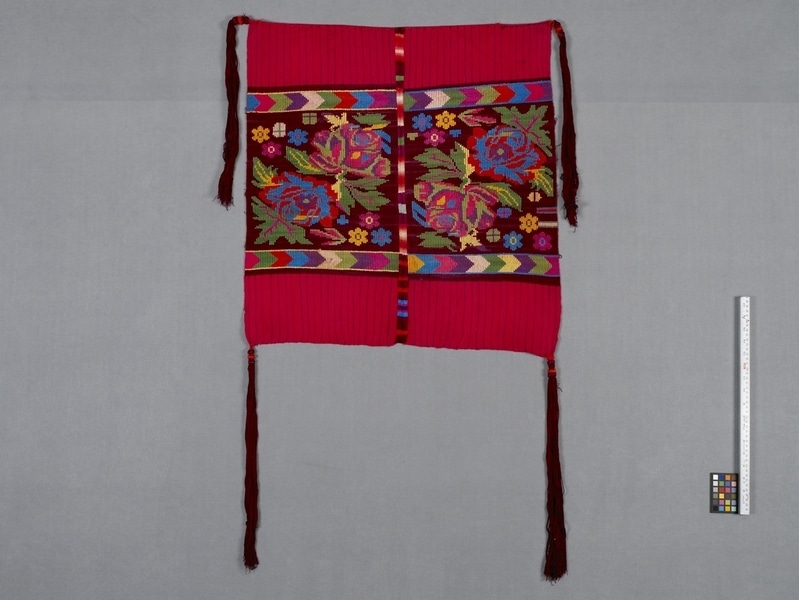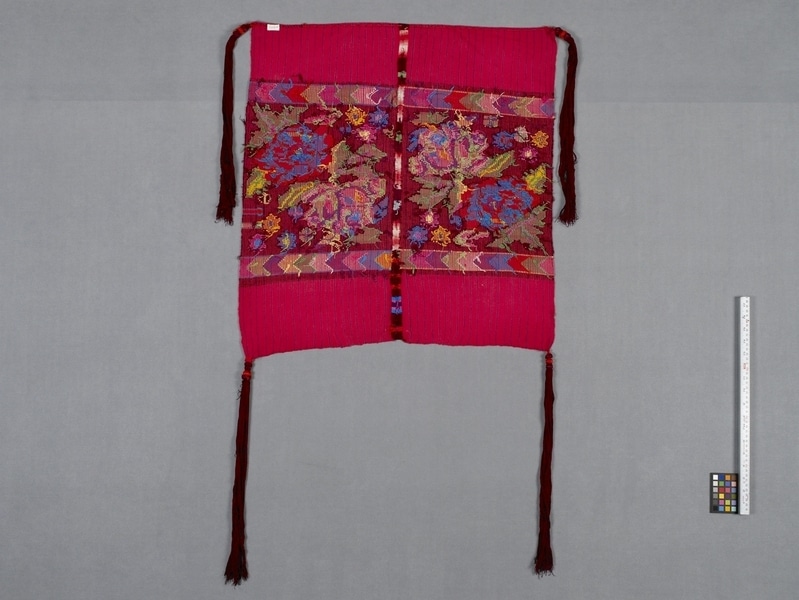Headdress Item Number: Sa207 from the MOA: University of British Columbia


Description
Headdress composed of two rectangles of red cotton with blue stripes joined at the centre by multicoloured insertion stitch embroidery (randa). The headdress is decorated with a wide band of multicoloured floral design brocade flanked by bands of multicoloured chevrons and has a tassel of untwisted maroon silk at each corner.
History Of Use
These tasselled tzutes or red headdresses, with elaborate, tapestry brocade weavings are woven by women on back strap looms and hand embroidered for men in Chichicastenango. Part of a ceremonial costume.
Iconographic Meaning
The 4 tassels are symbolic of the 4 legs of animals.
Cultural Context
ceremonial
Specific Techniques
Probably backstrap loomed cloth made from a (32.5 cm wide) 4-selvedge weaving that has been cut in half laterally and joined together lengthwise to form a square; band of decorative embroiderey stitches known as randa at the seam. One side has hand-stitched hem; selvedge edges on the other three. Warp-faced plain weave ground fabric with warp stripes (pinstripes). Central panel features two-faced supplementary cotton (?) or acrylic (?) weft patterning (pattern is reversed on the back face of the cloth). Warp: pair of singles; weft: 6 singles. Supplementary weft: four 2-ply over four warps; weft has been "raised" by the weaver to create a slight pile effect on the ground weave. Tassles added to each of the four corners feature knotted and wrapped orbs.
Item History
- Made in Chichicastenango, Quiche, Guatemala before 1976
- Collected by Inge Ruus during 1976
- Owned by Inge Ruus before August 5, 1977
- Received from Inge Ruus (Seller) and Museum of Anthropology Donations Fund (Funding source) on August 5, 1977
What
- Name
- Headdress
- Identification Number
- Sa207
- Type of Item
- headdress
- Material
- cotton fibre, silk fibre and dye
- Manufacturing Technique
- dyed, woven, hand stitched, embroidered, knotted and wrapped
- Overall
- height 66.0 cm, width 68.0 cm
Who
- Culture
- Quiche
- Field Collector
- Inge Ruus
- Previous Owner
- Inge Ruus
- Received from
- Inge Ruus (Seller) and Museum of Anthropology Donations Fund (Funding source)
Where
- Holding Institution
- MOA: University of British Columbia
- Made in
- Chichicastenango, Quiche, Guatemala
When
- Creation Date
- before 1976
- Collection Date
- during 1976
- Ownership Date
- before August 5, 1977
- Acquisition Date
- on August 5, 1977
Other
- Item Classes
- textiles
- Condition
- good
- Accession Number
- 0404/0001 d